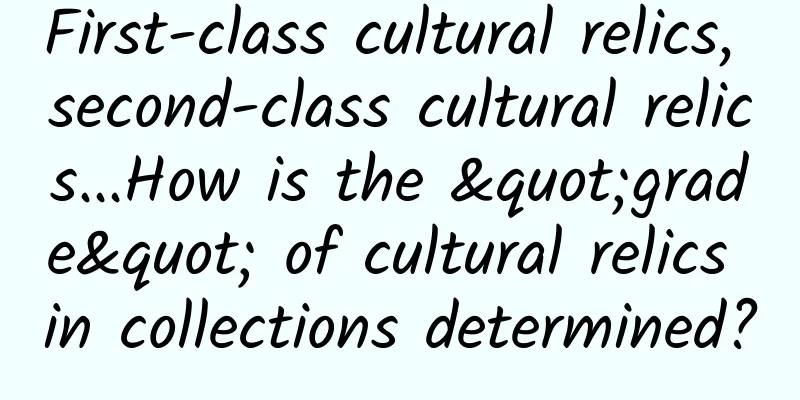First-class cultural relics, second-class cultural relics...How is the "grade" of cultural relics in collections determined?

|
Every time I visit a museum, I am attracted by the cultural relics with distinct characteristics of the times and typical local cultural styles. The information on the labels beside them usually includes basic information such as name, era, time of excavation, and location of excavation. Although everyone knows that cultural relics need to be classified, what is the classification of cultural relics? What are the standards for cultural relics classification? Next, let's take a few minutes to let everyone understand the classification rules of cultural relics in my country's collections. The classification of our country's cultural relics is mainly based on the "Cultural Relics Protection Law of the People's Republic of China", which is equivalent to the constitution of cultural relics. Then there is the "Detailed Rules for the Implementation of the Cultural Relics Protection Law of the People's Republic of China", and the specific operating provisions are determined according to the detailed provisions. Cultural relics collections are divided into precious cultural relics and general cultural relics. Among them, the first, second and third grade cultural relics are all precious cultural relics. In addition, there are general cultural relics and unclassified cultural relics, which are all classified as general cultural relics in the cultural relics department. According to the historical, artistic and scientific value of the cultural relics, the particularly important ones are classified as first-level cultural relics, the important ones are classified as second-level cultural relics, and the relatively important ones are classified as third-level cultural relics. Those classified as general cultural relics must also have certain historical, artistic and scientific values. Seeing this, we may have a question: how to define the historical, artistic, and scientific value of cultural relics? You have to check this out. The State Administration of Cultural Heritage has explained it in the "Criteria for the Classification of Cultural Relics Collections". There are 14 standards for classifying first-level cultural relics, 12 standards for classifying second-level cultural relics, and 11 standards for classifying third-level cultural relics. What about ordinary cultural relics? In fact, there is no strict term for the classification of cultural relics, but there is a term called "general cultural relics", which has 7 classification standards. Some people may say that the classification standards are too complicated and difficult to understand. Don’t the experts on TV also make mistakes in dating and make mistakes? So who should grade cultural relics? Don’t worry, the classification of cultural relics is described below: First-class cultural relics need to be evaluated by the State Administration of Cultural Heritage, and the classification of second-class and third-class cultural relics and general cultural relics must be organized and evaluated by provincial cultural relics administrative departments, and only after a written and sealed document is issued can they be called precious cultural relics. Unclassified cultural relics are other collections of cultural relics that have not been submitted to cultural relics administrative departments at all levels for evaluation. In other words, the rating of cultural relics is decided by professional departments organizing professionals to jointly study, discuss and consult. It is not something that can be decided by a TV station organizing a few treasure appraisal experts to take a look. Of course, there are indeed some master-level experts, but if the process is wrong, even if the cultural relics they identify are accurate, they are not the basis for rating. It should be noted that the cultural relics classification we are talking about here only applies to domestic cultural relics and Chinese cultural relics lost overseas, and does not apply to foreign cultural relics. Source: Chongqing Science Writers Association Author: Zou Qinjia, 2021 Cultural Relics and Museums major of Hebei Oriental University, and Xiong Deshan of Yongchuan Museum Audit expert: Li Hanbin Statement: Except for original content and special notes, some pictures are from the Internet. They are not for commercial purposes and are only used as popular science materials. The copyright belongs to the original authors. If there is any infringement, please contact us to delete them. |
<<: AI and scientists work together to uncover the charred "scroll" under Mount Vesuvius
Recommend
Do you believe that high-quality vegetables without insects or pollution can be grown under the sea?
The May 3 issue of Nature News published a photo,...
6,000 worms in one snail! What kind of snail can eat so much?
Audit expert: Li Weiyang Well-known science write...
What is Encyclopedia Promotion? How to do Encyclopedia Promotion?
With the continuous development of the Internet, ...
If one person is infected, the whole family needs to be treated! Zhang Wenhong: If we eat like this at home, we will see germs everywhere!
If one person is infected, the whole family must ...
"Looking through the stars, exploring the moon palace!" The names of the lunar suit and manned lunar rover for China's manned lunar exploration mission are officially confirmed
According to the China Manned Space Engineering O...
Re-understand the brand’s “differentiation”!
Creating "differentiation" has become a...
It turns out that it is Dialog that causes memory leaks in Android
1. Memory leak bugs surge Recently, I detected so...
A question for self-media people to ask themselves: Are your fans really your own fans?
Weibo held a "Super Celebrity Festival"...
IEA: Global energy sector roadmap to net zero emissions by 2050 (210 pages)
According to the Roadmap, near-zero emissions wil...
How much does it cost to develop a mini program? How much does it cost to make a mini program?
With the rapid development of the Internet, mini ...
PERKINS COIE: Emerging Technology Trends Report 2022
PERKINS COIE released the "2022 Emerging Tec...
Next time your boss asks you to refactor your system, let him read this article
[[155440]] Everyone is unhappy with the old legac...
How can we encourage users to actively share and attract traffic?
01 Since the Internet traffic dividend began to g...
The worst outcome for LeTV is that Jia Yueting loses control. How can the stock price collapse?
After writing the article, I suddenly realized th...
"Flying geese stepping on snow and mud"! The 85-year-old academician made three wishes on his birthday...
"The seabed is so beautiful, with sea lilies...









